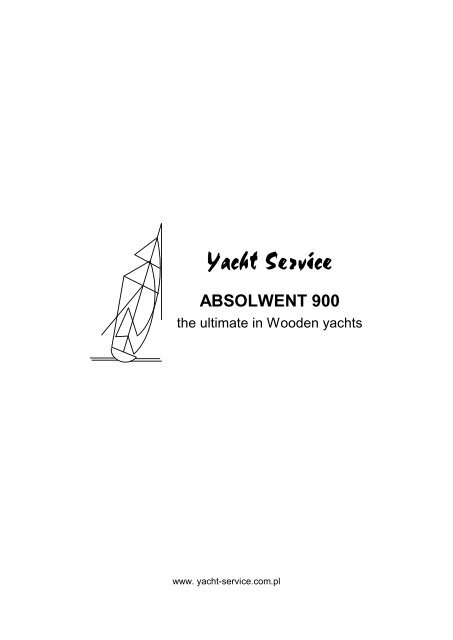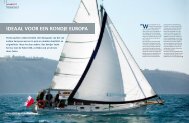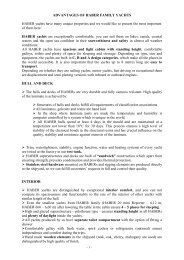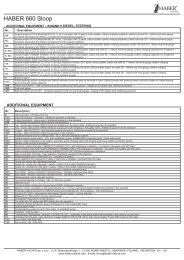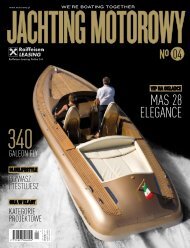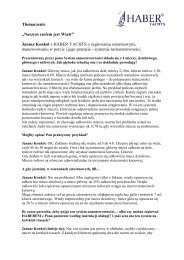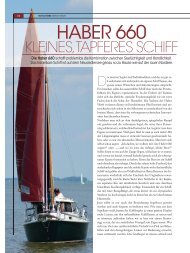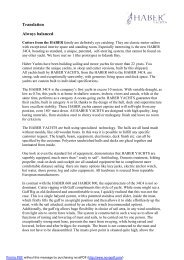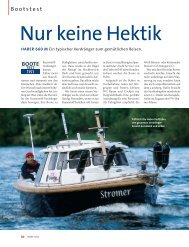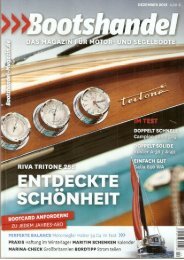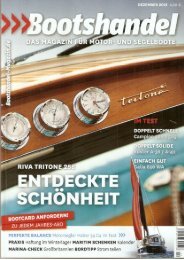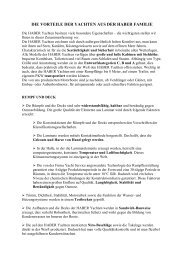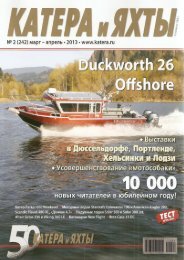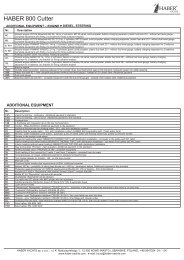ABSOLWENT 900 - HABER YACHTS
ABSOLWENT 900 - HABER YACHTS
ABSOLWENT 900 - HABER YACHTS
Create successful ePaper yourself
Turn your PDF publications into a flip-book with our unique Google optimized e-Paper software.
<strong>ABSOLWENT</strong> <strong>900</strong><br />
the ultimate in Wooden yachts<br />
Absolwent <strong>900</strong><br />
www. yacht-service.com.pl
1. A General Background of the<br />
“Absolwent <strong>900</strong>” Enterprise<br />
The genesis of the “Absolwent <strong>900</strong>” (Graduate<br />
<strong>900</strong>) is closely connected with her designer Janusz<br />
Konkol. The story of his mastery goes back to the<br />
1960s when his first significant contact with water was<br />
established and the building of wooden kayaks began.<br />
Then there follows his first own construction - a sailing<br />
kayak, the first fruit of his dreams about yachts and<br />
sailing.<br />
Later he works in Gdansk, at the Stogi Shipyard<br />
(now the Conrad Shipyard), which specialises in yacht<br />
constructions. At the same time Konkol sails at the<br />
Gdansk Shipyard Yacht Club. Under Wacław<br />
Liskiewicz’s watchful eye he climbs the steps of a<br />
professional career - apprentice, boat builder,<br />
production engineer, constructor. He works on the type<br />
“Opal” and other kinds of boats with traditional and<br />
diagonal plating and learns from Emil Kisły shipwright<br />
skills on wooden Finns and Flying Dutchmen.<br />
At that time he begins studies at the Ship Building<br />
Department of Gdansk Technical University. This<br />
period gives him an opportunity to become familiar<br />
with the West System Technology through Fritz<br />
Marrgraff’s “Lisoletta 1000” from Lake Constance.<br />
The new interest resulted in his master’s thesis: A<br />
Project of a Wooden Sailing Yacht in the West System<br />
Technology.<br />
After graduating he continues his professional<br />
career in the Yacht Club “Neptun” where he takes a<br />
new view of yachts. The new experience gives rise to an<br />
exciting and constructive clash between habits,<br />
shipyard dogmas and tradition on the one hand and the<br />
unrestrained competitive venture of amateurs creating<br />
better and better sailing units on the other. Talking<br />
about the above we must not forget the significance of<br />
Henryk Brylski’s ideas, the man who is the driving<br />
force behind the Yacht Club “Neptun” and the author<br />
of two most original constructions “Haber 555” and<br />
“Haber 700.”<br />
The next stage in Konkol’s life is inseparably<br />
combined with I3awa, a town in northern Poland that<br />
has got huge potential, and the wonderful atmosphere<br />
of a water sports and tourism centre. After a few years’<br />
break the constructor comes back to his profession and<br />
founds the Yacht Service Co. in partnership with<br />
Tadeusz Świst. (Presently Yacht Service Sp. z o.o.)<br />
Finally the commission of a lifetime - a modern<br />
wooden yacht. This is, very briefly, the story that<br />
constitutes the background of the “Absolwent <strong>900</strong>”<br />
enterprise.<br />
2. Specifications<br />
2.1. An Introduction<br />
The design and carpentry of the yacht are based on<br />
the most recent constructional and technological<br />
solutions so that the unit can join the best qualities of a<br />
sleek and swift sailing yacht and elegance of natural<br />
materials. The West System Technology ensures the<br />
unlimited functionality of the yacht, its full resistance<br />
and absolute safety, immense comfort, easy transport<br />
and service.<br />
The materials used in the production are of the<br />
highest quality. Those especially significant for the<br />
resistance of the yacht have certificates of relevant<br />
classification societies - Germanischer Lloyd, Lloyd’s<br />
Register of Shipping, Polish Register of Shipping, etc.<br />
The construction plans have been drawn according<br />
to PRS classification requirements for unlimited<br />
navigation and have been accepted by that society. PRS<br />
also supervises the production.<br />
Measurements:<br />
• length over all 9.00 m (29’ 6’’)<br />
• length at waterline 7.70 m (25’ 26’’)<br />
• beam 2.80 m (9’ 2’’)<br />
• draught 0.48 m (1’ 6’’)<br />
• draught with the centreboard dropped<br />
2.08 m (6’ 9”)<br />
• displacement - ocean navigation 3.70 t<br />
• ballast<br />
1.05 t<br />
• centreboard<br />
0.25 t<br />
• sail area 44.00 m 2 (473 ft 2 )<br />
Area of sailing: cean navigation - class * yKx<br />
2.2. Hull<br />
The frame consists of a system of lengthwise and<br />
crosswise reinforcements made up as a strip-andplywood<br />
construction. The reinforcements function also<br />
as elements of the internal framework: partitions,<br />
shelves, walls of berths, etc. The main, load-bearing<br />
element is the keel with inlaid floor frame elements,<br />
centreboard case and bulkheads.<br />
The plating are two four-millimetre-thick layers of<br />
Okume mahogany (White mahogany) plywood, laid<br />
with Ashcroft’s method, and an outer two-and-a-halfmillimetre-thick<br />
layer of Sapeli mahogany face veneer.<br />
The latter is laid lengthwise in a way resembling a<br />
traditional caravel planking made in tune with the<br />
traditional carpentry precepts that apply to the plating<br />
of this kind. The face veneer is covered with a layer of<br />
transparent epoxy laminate which is, in turn, protected<br />
by four layers of the two-component varnish “West<br />
System 1000” characterised by increased resistance to<br />
ultraviolet light.<br />
When stored or transported the hull is supported at<br />
three points strongly linked with the construction: one<br />
Absolwent <strong>900</strong>
on the line of the keel in front of the centreboard case<br />
and two symmetrically under the stern. In such a way<br />
the yacht can be stood directly on the ground without<br />
any additional substructure.<br />
2.3. Deck<br />
The deck plating is based on two-part deck beams<br />
and deck stringers. The sides of the deckhouse have<br />
been carpentered of special Khaya mahogany (Red<br />
mahogany) plywood. Both the deck and the deckhouse<br />
platings are inlaid with thermal insulation in the living<br />
area of the vessel.<br />
First from the inside is a white dressing layer<br />
followed by twenty millimetres of insulation which<br />
hides PVC pipes with electric conduits. The third is an<br />
Okume mahogany plywood layer which is fastened to<br />
the upper surfaces of the deck beams and stringers.<br />
Finally, there comes six-millimetre-thick teak laid like<br />
traditional planking. Owing to such a construction the<br />
deck is easy to maintain and has good nonslip<br />
characteristics.<br />
The hatch is equipped with a wave deflector that<br />
prevents waves from the bow from getting inside the<br />
yacht. Both the hatch and the deflector have been made<br />
on preparatory frames as self-bearing elements.<br />
The self-draining cockpit is made of teak. Only the<br />
side walls of the cockpit are made of mahogany<br />
plywood.<br />
All the mahogany elements are proofed and<br />
varnished. The cockpit floor is equipped with a grating<br />
and the cockpit benches with strip-gratings. There is<br />
also an aft locker for two gas cylinders and a hand bilge<br />
pump.<br />
2.4. Interior furnishings and equipment<br />
On both sides of the vessel there are two levels of<br />
shelves built-in lengthwise. In the bow there is an<br />
anchor chain locker. In order towards the stern are:<br />
2.4.1. Forepeak<br />
• double berth<br />
• net for sails<br />
• wardrobe<br />
• cabinet with shelves<br />
• vestibule<br />
• two fresh water tanks and room for a third one<br />
• Lewmar hatch - headroom: 1.75 m (5’ 8’’)<br />
• fixed side windows<br />
2.4.2. Mess<br />
• maximum headroom: 1.83 m (6’)<br />
• big folding table on the centreboard case<br />
• double folding bunk on the port and fresh and<br />
dirty water tanks under the bunk<br />
• on the starboard - bunk; drinking and outside<br />
water pumps, pressure vessels and distribution<br />
valves under the bunk<br />
• folding chart board (half-chart size) with a map<br />
pocket, nautical instrument holders; electric<br />
current distribution panel and radio above and<br />
beside the navigation board<br />
• two opening Vetus windows and two fixed ones<br />
• galley, combined with the mess as one room:<br />
• sink<br />
• fresh water tap (pressure system of water<br />
supply, reserve foot pump)<br />
• hot and cold water tap<br />
• dirty water draining system<br />
• Engel 15 refrigerator or any other cooling<br />
machine for individual orders<br />
• two-burner gimbaled cooker<br />
• various stowage<br />
• electric Ventair ventilator<br />
• electric bilge pump (100 l/min. = 22 imp.<br />
gal./min.) - automatic or manual mode<br />
2.4.3. Heads (headroom: 1.75 m = 5’ 8’’)<br />
• shower<br />
• tap<br />
• water draining system<br />
• drainage valves of dirty water<br />
• washbasin<br />
• chemical toilet<br />
• heating Eberschpacher unit<br />
• boiler for hot water supply<br />
• opening Vetus window<br />
• two-way Ventair ventilator<br />
Under the cockpit there is a soundproof engine<br />
chamber with a ladder on the front door and opening<br />
doors on both sides of the chamber for operating the<br />
engine. In addition, under the engine there is a special<br />
basin preventing spreading of the fuel and engine oil<br />
into the bilge in case of breakdown.<br />
2.4.4. Aft cabin<br />
• vestibule with an opening Vetus window<br />
• double berth - an opening Lewmar window in<br />
the cockpit wall<br />
2.4.5. Aft locker<br />
At the bottom there are fuel tanks, storage battery<br />
case and a plywood floor above. Thus there is still an<br />
eighty-centimetre-deep locker for sails, ropes, etc.<br />
2.4.6. Water supply system<br />
• basic pressure system - electric pumps, boiler<br />
(220-volt + engine), fresh water<br />
• emergency system - fresh water foot pump<br />
• fresh water tanks - 270 - 330 l (59 - 72 imp. gal.)<br />
in total<br />
• dirty water tank - 110 l (24 imp. gal.)<br />
2.4.7. Bilge system<br />
Absolwent <strong>900</strong> 2
• electric pump<br />
• Whale-Titan Gusher hand pump – coordinated<br />
with dirty water draining system<br />
2.4.8. Electrics (12 V)<br />
• two storage batteries<br />
• electric current distribution panel – electric<br />
current meters and sixteen automatic fuses<br />
• rectifier<br />
• 220-volt socket<br />
• interior lighting - nine lighting points:<br />
• forepeak - three points<br />
• mess - one point<br />
• galley - one point<br />
• navigation board - one point<br />
• toilet - one point<br />
• aft cabin - two points<br />
• deck and navigation lights<br />
2.4.9. Heating system<br />
• fuel-fired Eberspacher heating unit<br />
• heating factor: hot air<br />
• heating outputs:<br />
• forepeak<br />
• mess<br />
• toilet<br />
• aft cabin<br />
2.4.10. Gas supply system<br />
• gas cylinders under the deck in the cockpit<br />
• copper pipe<br />
• cut-off valve at the cooker<br />
• gas detector<br />
• two-burner cooker<br />
2.4.11. Air conditioning<br />
• opening windows<br />
• vertically sliding door with a louvred ventilator<br />
• electric ventilators<br />
• water trap ventilators<br />
2.4.12. Ballast (ca. 1.05 t)<br />
Lead blocks are suspended between the floor and<br />
the plating in the bilge. They are fastened to the<br />
crosswise floor frame elements with stainless steel<br />
elements.<br />
2.4.13. Centreboard - NACA profile for ballast<br />
fin (ca. 0.25 t)<br />
It is a steel construction covered with epoxy<br />
laminate. An appropriate system of fastening and<br />
blocking the blade prevents the centreboard from<br />
hitting the case and makes all the forces and loads be<br />
taken over by the left, solid part of the under-mast<br />
bulkhead and the keel. The centreboard is pivoted in<br />
front so that it lifts automatically in case of meeting an<br />
obstacle. It may be blocked after dropping and raised<br />
with a tackle and a winch. The centreboard halyard and<br />
blocking system are operated from the cockpit.<br />
2.4.14. Rudder - NACA fin profile<br />
• stainless steel yoke and wooden tiller<br />
• blade - steel construction covered with epoxy<br />
laminate<br />
• blade raising tackle, downhaul<br />
2.4.15. Stern stabilisers<br />
Yacht ardency is controlled and course stability<br />
ensured especially during full course sailing.<br />
2.4.16. Engine<br />
• Volvo Penta 2002 R FWC<br />
• folding Gorii propeller<br />
• steering from the cockpit<br />
• fuel tank - 90 l (19 imp. gal.)<br />
2.4.17. Rigging<br />
• standing rigging<br />
• dismountable mast standing on the deck<br />
and<br />
laid on a special support in the stern after<br />
lowering, boom, telescopic spinnaker<br />
booms - aluminium<br />
• telescopic boom tensioner<br />
• forestay, shrouds: string rope 1 x 19,<br />
diameter 5 mm (0.2 in); backstay: string<br />
rope 1 x 19, diameter 4 mm<br />
• stay tackle and anchor winch, rotary<br />
support,<br />
two-stage immovable support with an<br />
anchor rope and life buoy rope windlasses<br />
in<br />
the stern; mast guiding system<br />
• running rigging<br />
• quick reefing and main sail clearing<br />
systems<br />
“lazy Jack”<br />
• furling and reefing foresail “Profurl” with<br />
a double boltrope groove<br />
2.4.18. Deck equipment<br />
• double rope side railing, stern pulpit with a<br />
fender<br />
rack, bow pulpit, anchor CQR and anchor device<br />
• bow ladder for dismounting from the vessel<br />
• stern ladder for descending to the water<br />
• winches:<br />
• two Lewmar 16 ST self-tailing sheet<br />
winches<br />
• Lewmar 7 anchor winch<br />
• two Lewmar 16 halyard winches<br />
• rope clutches<br />
• Autohelm 50 electronic equipment<br />
• log (speed, daily route, total route)<br />
Absolwent <strong>900</strong> 3
• echo sounder<br />
• wind speed and direction meter<br />
2.4.19. Other accessories<br />
• six fenders<br />
• four mooring ropes<br />
• one towing warp<br />
• two anchors<br />
• one boathook<br />
• two fire-extinguishers<br />
3. Tests<br />
3.1. Tests under sail<br />
Place:<br />
The Gulf of Gdansk<br />
Time: 26 th October 1994<br />
Wind velocity: 10-12 kn.<br />
The state of the sea: 1-2<br />
The tests carried out in the presence of PRS<br />
inspectors, Messrs Zbigniew Rudnicki and Benedykt<br />
Korybalski<br />
3.1.1. Yacht’s velocity distribution on courses<br />
The tests were begun on the close-hauled starboard<br />
tack through falling off to running, followed by gybing<br />
and luffing to the close-hauled port tack. In irons: 80°.<br />
3.1.2. Sail balance<br />
Full control over the sail balance from luffing<br />
through ideal balance to falling off by dropping and<br />
raising the rudder blade with the halyard and downhaul<br />
tackles.<br />
Supporting the balance with stern stabilisers:<br />
• windward - steering facilitated at high wind<br />
velocities<br />
• leeward - very good course stability after raising<br />
the centreboard and dropping the stern<br />
stabilisers.<br />
The yacht went self-steered for a longer time.<br />
Correcting the course required minimal rudder<br />
turns.<br />
3.1.3. Going about and gybing<br />
• going about: sailing on a beam reach - luffing –<br />
going about - falling off to the beam reach on the<br />
other tack. Time - 18 s.<br />
• gybing: sailing on a beam reach - falling off –<br />
gybing - luffing to the beam reach on the other<br />
tack. Time - 10 s.<br />
3.1.4. 360° turn<br />
• sailing on a beam reach - luffing - going about –<br />
falling off - gybing - luffing to the beam reach.<br />
Time - 36 s.<br />
• sailing on a beam reach - falling off - gybing –<br />
luffing - going about - falling off to the beam<br />
reach. Time - 38s.<br />
The diameter of the turn: ca 14 m (46 ft.)<br />
3.1.5. The figure of eight<br />
Absolwent <strong>900</strong> 4
a. through tacking: sailing on a broad reach –<br />
luffing - going about - falling off to the broad<br />
reach - luffing - going about - falling off to the<br />
broad reach. Time - 47 s.<br />
b. through gybing: sailing on a close reach –<br />
falling<br />
off - gybing - luffing to the close reach - falling<br />
off - gybing - luffing to the close reach.<br />
Time - 46 s.<br />
3.1.6. Maximum speed reached at the tests<br />
V max. = 8.4 kn. (true wind velocity: 22 - 24 kn.;<br />
the course in respect to the true wind: ca 130°; sails:<br />
main sail 1 st reef + foresail = 28 sq. m/301 sq. ft.)<br />
3.2. Tests under engine power<br />
Date: 7 th September, 1994<br />
Engine:<br />
Volvo Penta 2002 R FWC<br />
Folding Gorii propeller<br />
True wind velocity: 10 m/s (19 kn.)<br />
Crew:<br />
8 pers.<br />
3.2.1. Speed test<br />
No. Engine rotational speed in Yacht speed windward in knots Yacht speed leeward in knots<br />
r.p.m.<br />
1. 1500 3.8 4.2<br />
2. 2000 5.1 5.5<br />
3. 2500 6.3 6.5<br />
4. 2<strong>900</strong> 7.0 7.1<br />
3.2.2. Slowing-down test (leeward)<br />
a. V max. = 7.1<br />
b. two-second inert sailing<br />
c. slowing down from the speed V = 6.2 (speed<br />
reduction during the inert sailing)<br />
d. smooth change to the reverse gear, increasing<br />
engine rotational speed<br />
e. total time of slowing-down from the speed<br />
s.)<br />
V = 7.1 to a standstill: 13 s. (from V = 6.2: 11<br />
f. slowing-down distance from the change to the<br />
reverse gear to a standstill: the yacht’s length<br />
g. slowing-down distance from the beginning of<br />
the inert sailing to a standstill: 20 m (65 ft.)<br />
3.2.3. 360° turn<br />
No. Engine rotational V init. in knots V term in knots Time in seconds 360° turn diameter<br />
speed<br />
1. 1500 3.9 0.4 30 L + 2 m = 11 m<br />
2. 2000 5.3 1.3 22 L + 4 m = 13 m<br />
3. 2500 6.6 2.3 19 L + 4 m = 13 m<br />
4. 2<strong>900</strong> 7.1 2.6 18 L + 5 m = 14 m<br />
3.3. Stability tests<br />
On August 30 th , 1994 in I3awa the yacht was tested for stability in concord with the regulations, part III, in the<br />
presence of the constructor, carpenter and PRS inspectors Messrs Słonimski and Rudnicki. The tests were done in two<br />
ballast versions and with the centreboard dropped and raised, at a ratio of 1:2: mode 1 - ballast 1020 kg, centreboard<br />
raised, mode 2 - ballast 1020 kg, centreboard dropped, mode 3 - ballast 840 kg, centreboard dropped, mode 4 - ballast<br />
840 kg, centreboard raised.<br />
Absolwent <strong>900</strong> 5
Specifications: l = 11.4 m (37’ 4”); h3 = 0.65 m (2’ 1”); free board = 0.96 m (3’ 1”); h2 = 11.4 m (37’ 4”); hwith<br />
centreboard raised = 5,575 m (18’ 3”); hwith centreboard dropped = 5,825 m (19’ 1”); k = 3,500 kg = 34,335 N in<br />
modes 1 and 2; k = 3,320 kg = 32,569 N in modes 3 and 4.<br />
In mode 2 the yacht’s righting moment is insignificantly insufficient at the heel angle of 30°; yet the maximum<br />
righting moment at 60° is bigger than required. The weight of the centreboard : 240 kg.<br />
In mode 1 the righting moment is too small at the heel angle of 30° and the maximum moment is insufficient at<br />
50°<br />
In modes 3 and 4 the value of the righting moment is too small at 30° and the maximum righting moment is<br />
insufficient at 60° with the centreboard dropped and at 50° with the centreboard raised.<br />
On the basis of the results of the tests for the heel angle in dependence on the number of persons standing on a<br />
yacht’s side (max. 8) it was stated that the condition had been met in all the modes.<br />
FINAL CONCLUSION: When sailing on the open sea the yacht should be set into mode 2 and in fairly good<br />
weather conditions into mode 1. In mode 2 in bad weather the centreboard should be blocked when dropped. The<br />
permanent ballast placed in concord with the approved documents must not be smaller than 1020 kg.<br />
Legend:<br />
k - displacement<br />
h 2 - a vertical distance between the point of the fastening of the line used at the test and the centre of the hull’s<br />
rotation<br />
h 3 - a vertical distance between the lower fastening of the line tackle used at the test and the surface of the water<br />
h with centreboard raised - a distance between the centre of the lateral resistance surface of the submerged hull with the<br />
centreboard raised and the centre of the sail area.<br />
h with centreboard dropped - a distance between the centre of the lateral resistance surface of the submerged hull with the<br />
centreboard dropped and the centre of the sail area.<br />
l - a horizontal distance between the point of the fastening of the line used at the test and the centre of the hull’s<br />
rotation<br />
Absolwent <strong>900</strong> 6
January 2011<br />
The yacht „Absolwent <strong>900</strong>” sailing on polish inshore and offshore waters from 1994 proved its<br />
universality. It also sailed on lakes, canals, rivers and Baltic Sea. Excellently performed, with a lot<br />
of unique solutions confirmed all design assumptions. It did well in many hard conditions presenting<br />
big seaworthiness.<br />
It has been again now for 4 years in hands of its designer and builder. It is kept in very good<br />
conditions and under supervision. Construction of the yacht is in ideal state, there are no any<br />
damages to the strengthening elements of the hull and the wood is not rotten.<br />
Our offer includes the yacht with its service, connected with partial exchange of installation and<br />
some devices and restoration. All these works are to bring the full, original use and aesthetic<br />
properties to it. “Absolwent <strong>900</strong>” awaits a new owner and can be also additionally equipped<br />
accordingly to its wishes.<br />
Janusz Konkol<br />
Designer i bilder<br />
13 – 300 Nowe Miasto Lubawskie<br />
ul. K. Makuszyńskiego 1, Polska<br />
Tel. 0048 56 472 54 04<br />
Tel./Fax 0048 56 472 54 24<br />
e-mail: haber@yacht-service.com.<br />
www.: yacht-service.com.pl


